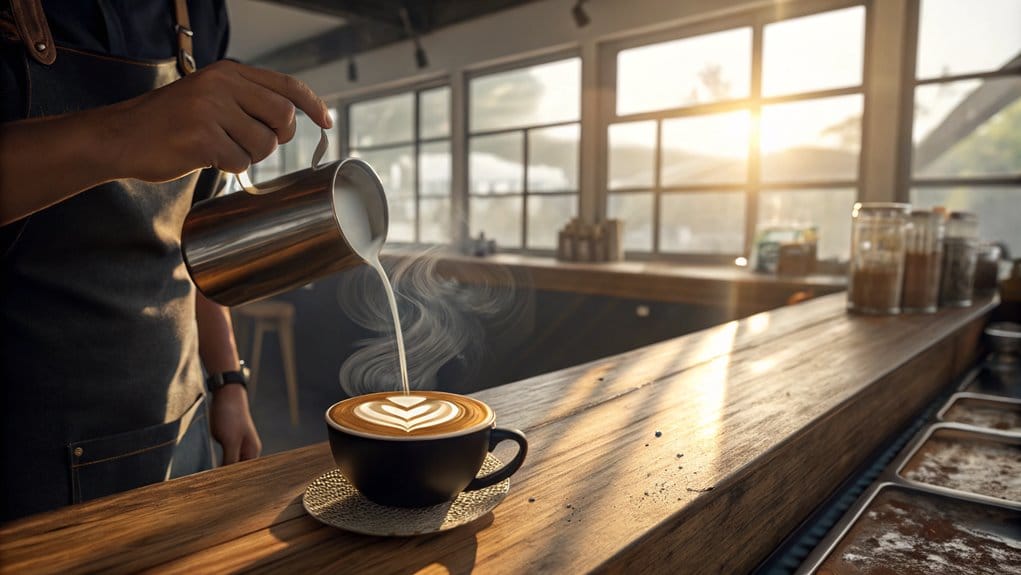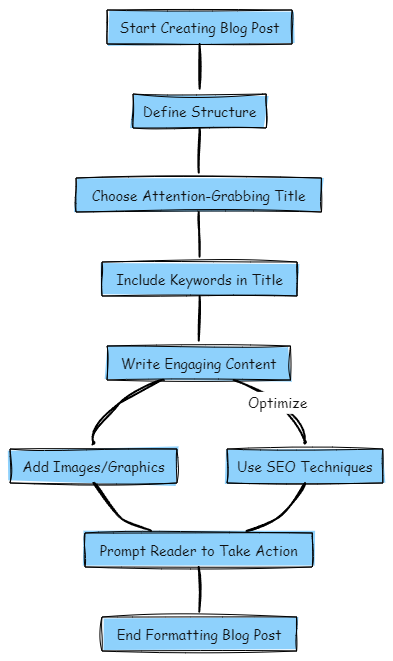

When you polish the look and feel of your blog[1] post, it’s like giving your readers an easy-to-follow map. Just like road signs guide us on a journey, clear headings and a consistent style guide your readers through your content. Think about what your readers are searching for and tailor your content to answer their questions.
How about mixing it up a bit? Lists and step-by-step guides can keep your readers interested. A catchy title that mirrors your content is a must. And don’t forget to sprinkle in those SEO keywords to help your post pop up in search results.
Let’s not ignore the power of pictures and calls to action (CTAs). They can work like magnets, pulling your readers deeper into your content.
So, why not give your blog post formatting a little more thought? You might just uncover some golden nuggets to boost your blog’s impact.
Grasping the art of blog post formatting is a game-changer. It’s not just about the words you write, but how you present them. It’s like serving a meal – the presentation matters. Start with a clear heading hierarchy for a structured look. Then, stick to a consistent style for a polished feel. Don’t forget to throw in visual elements. Why? They make your text more digestible and bring your points to life.
But, that’s not all. Consider something called search intent. In simple terms, it means figuring out what your readers are looking for and making sure your blog post delivers it. This way, you’re not just answering their queries, but doing it in a way they find clear and engaging.
The icing on the cake? Picking the right blog format. It could be a list, a guide, or even a how-to article. The trick is to choose what fits your content and audience like a glove.

Diving into formatting, we can’t ignore its deep effects on reader involvement and website position. The right format in a blog can spotlight main ideas, guaranteeing clear communication that captures the reader’s focus. This doesn’t just lift reader involvement but also helps to boost the blog’s spot in search engine results.
A well put-together format ramps up on-blog conversations, leading readers through the content. It makes the blog easier to read. This, in turn, leads to more time spent on the page, enhancing the total user experience. So, formatting’s importance in a blog isn’t just about looks—it’s a tactical tool with a big role in the blog’s success.
Diving deeper into the world of blog formatting, it’s clear that the secret to gripping content is figuring out what our readers are searching for. Once we know their search intent, we can make content that hits the mark, engaging and relevant to them.
Navigating through various blog post styles can significantly influence how your content hits the mark with your audience. Each post style suits different reader needs and tastes, so picking the right one is key to crafting your content.
| Blog Style | Great for |
|---|---|
| List-style posts | Offering bite-sized information |
| Step-by-step guides | Giving easy instructions |
| Comparison or review pieces | Sharing product or service reviews |
| Comprehensive guides | Deep-diving into a subject |
Using blog templates can help shape your post and give it structure. Adjusting your post style to align with what readers are searching for can boost reader involvement and make your content more relevant. Keep in mind, the style of your blog is a basic tool for helping readers grasp and engage with your material.
Ready to elevate your website’s search engine ranking but not sure where to start? Let our expert team guide you through the maze of SEO with proven strategies and personalized advice. Contact us through our contact page or reach out directly via WhatsApp to start transforming your online presence today!
Now that we’ve tackled choosing the right blog post format, let’s dive into the skill of creating compelling blog post titles. This is crucial to catch your reader’s eye and hold their interest.
When it comes to blog post titles, here are some time-tested tips:

When diving into the world of blog writing, it’s crucial to sketch out a blog post outline. This simple step ensures your content flows smoothly, hooks your readers, and is easy to read. Outlines are especially important for longer blog posts – they act as a guide, ensuring you don’t leave out any important details. Using blog post templates can help you arrange your thoughts in a structured way.
| Blog Formatting | Techniques |
|---|---|
| Clear Headings | Use clear headings and subheadings for better organization of info |
| Simple Text | Use bullet points for clarity and short sentences to ease readability |
| Visual Elements | Incorporate tables and visual elements to boost reader engagement |
Once you’ve sketched out your blog post and given thought to its overall layout, it’s time to zoom in on the text formatting methods that can significantly boost your blog’s readability and interaction. Right text formatting is not just about enhancing the reader’s journey, but it’s also a crucial component of your content promotion blueprint.
Here’s what you should bear in mind when formatting your blog content:
By doing so, you’ll craft a blog post that’s not only easy for readers to digest, but also primed for online promotion. Always remember, the way your post is formatted influences how your readers perceive and interact with your web content.
The look of your blog post matters, but it’s just as crucial to ensure your content is easy to read. This hooks your readers and improves their time on your site. So, how do you make your posts readable?
Firstly, go big on fonts. This makes your text clear and easy to follow. Secondly, don’t shy away from white space. It highlights the important bits and makes your content easier to skim through.
Think of headers and subheaders as your guiding stars. They help readers navigate your content and understand its structure.
Next up is the magic of bullet points and numbered lists. Using these not only adds to your white space but also breaks down your content, making it simpler to digest.
In a nutshell, your aim is to make your blog posts as reader-friendly as possible. But, there’s a secret sauce to achieving this, and we’ll reveal that in our next post. Stay tuned!
Understanding the power of visuals can change the game in creating engaging blog posts. This tactic not only enhances the reader’s journey but also significantly increases their interaction with your content.
Adding elements like pictures, video clips, infographics, and graphs can magically turn a monotonous piece into a vibrant, interactive adventure. Here are some simple strategies to stir up feelings and engagement in your readers:
Diving into SEO and call-to-action, or CTA, can ramp up your blog’s visibility and reader engagement. Simply put, by using the right keywords in your posts, more people can find them.
Plus, a well-placed CTA can prompt readers to take action, boosting interaction. The trick is to balance SEO with reader-friendly content. This enhances both user experience and search engine visibility.
Cleverly weaving CTAs into well-structured blog posts can up your blog’s conversion rates and help your website perform better. These tactics can definitely make your blog posts more engaging and powerful.
But, what’s the secret to mastering this balance? Stay tuned to find out!
A top-notch blog post has a few key ingredients. First, you need a headline that grabs attention. Then, you sprinkle in bullet points and subheadings that are packed with meaning. Don’t forget to throw in some eye-catching visuals too. It’s all about looking at it from your reader’s point of view and making sure search engines will love it. Manage your word count, make it interactive and, of course, end with a punchy call to action that leaves readers wanting more.
A blog post, what’s that? It’s a way to share your thoughts, ideas, and knowledge with the world. But how should it look? Let’s break it down.
First off, it needs a catchy start – something to grab your reader’s attention. You know, like a fisherman’s hook. Next up, you need some engaging headlines, the kind that makes your reader want to know more. And don’t forget about subheadings – they break up the text and make it easier to digest.
Add some bullet points to make things clear and easy to understand. Maybe even throw in an infographic or two. These are like pictures that tell a story, adding some visual flair to your post.
Don’t just throw all your information at the reader at once. Break it up, segment it. It’s like serving a meal in courses rather than all at once.
Now, how should it end? Think of a crafted ending, something that ties everything together. But don’t just stop there. Add a call to action – tell your reader what they should do next.
And lastly, optimize your post. This is like polishing a diamond – it makes your post shine in the sea of content on the internet[3].
The ideal approach to penning a blog post is akin to having a chat with a friend. It involves weaving in your personal stories and tapping into the reader’s emotions. It’s important to write as if you’re in action, use brief sections, break text up under headlines, incorporate lists, and include images or videos. Encouraging your reader to do something, a “call to action”, can also boost interaction.
Let me break it down for you. Ernest Hemingway, a famous writer, had a set of rules he followed. Try using active voice, speak the truth, and use shorter sentences and paragraphs. These methods can help your writing be more engaging and easy to comprehend.
And here’s a little secret, leaving your readers with a cliffhanger can work wonders. It keeps them wondering, and more importantly, coming back for more. What’s the most powerful cliffhanger you can think of? Well, that’s a story for another day… 🙂
Setting up a blog post? Keep it simple. Start with a catchy headline to grab attention. Break your text into smaller parts using subheadings. Make sure you sprinkle in some SEO keywords to improve searchability. And don’t forget the visuals – they add color and life to your post.
To make it easy for your readers, use plenty of paragraph gaps and bullet points. It helps the eye and keeps your readers on the page. And at the end of it all, leave them with a question or a thought. Something that will make them want to come back for more. That’s your call-to-action.
